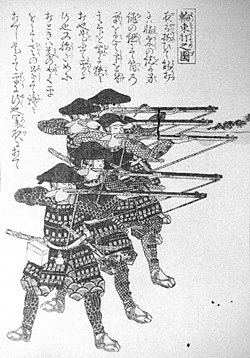Ashigaru

Ashigaru(Đủ khinh,"light of foot" )wereinfantryemployed by thesamuraiclass offeudal Japan.The first known reference toashigaruwas in the 14th century,[1]but it was during theAshikaga shogunate(Muromachi period) that the use ofashigarubecame prevalent by various warring factions.[2]
Origins
[edit]Attempts were made in Japan byEmperor Tenmu(673–686) to have a conscripted national army, but this did not come about, and by the 10th century Japan instead relied on individual landowners to provide men for conflicts and wars. These horse-owning landowners were the beginnings of the samurai class and the men who worked the land for the landowners became the common foot soldiers during times of war. These foot soldiers could have long ties and loyalty to the landowners which went back many generations.[3]
Every farmer was basically also a warrior untilHideyoshiconfiscated weapons through a nation-wide "sword-hunt" in 1588. Every ashigaru had his first lessons on the mentality of war from thebiwa hōshi.On the other hand, theHeikerecitations also propagated civic virtues: loyalty, steadfastness in adversity, and pride of family honor.
Land-owning samurai, together with farmer foot soldiers, fought in many wars and conflicts including the Mongol invasions of Japan in 1274 and 1281. Constant warfare between the 14th and 16th centuries made the hiring of foot soldiers with no particular loyalty necessary at times. Paid only in loot, thesemercenarieswere not well-trained and thus could not always be depended upon in battle. These wandering foot soldiers eventually became theashigaru.[5]
Weapons and armor
[edit]
Ashigaru were commonly armed withkatana,yari,andyumi.[2]Ashigaru armour varied depending on the period, from no armor to heavily armored and could consist of conical hats calledjingasamade fromiron,copper,wood,paper,bamboo,orleather,[6][7]dō(cuirasses),kabuto(helmets),tatami zukin(armored hoods),kote(armored sleeves),suneate(greaves), andhaidate(cuisses).
The warfare of theSengoku period(15th and 16th centuries) required large quantities of armor to be produced for the ever-growing armies of ashigaru. Simplemunition armour[8]cuirasses and helmets were mass-produced includingtatamiarmor which could be folded or were collapsible.[9]Tatamiarmor was made from small rectangular or hexagonal iron plates that were usually connected to each other by mail and sewn to a cloth backing.[10]
In the 16th century the ashigaru were also armed withmatchlocksof the type known astanegashima.[11][12]Small banners calledsashimonocould be worn on their backs during battle for identification.[13]
Service in war
[edit]
In theŌnin War,ashigaru gained a reputation as unruly troops when they looted and burned Miyako (modern-dayKyoto). In the followingSengoku periodthe aspect of the battle changed from single combat to massed formations.[14]Therefore, ashigaru became the backbone of many feudal armies and some of them rose to greater prominence.
Those who were given control of ashigaru were calledashigarugashira(Đủ khinh đầu).The most famous of them wasToyotomi Hideyoshi,who also raised many of his warrior followers to samurai status.
Introduction to firearms and new tactics
[edit]This sectionneeds additional citations forverification.(February 2011) |

Ashigaru formed the backbone of samurai armies in the later periods. The real change for the ashigaru began in 1543 with the introduction of matchlock firearms by the Portuguese. Almost immediately localdaimyōsstarted to equip their ashigaru with the new weapon, which required little training to use proficiently, as compared with the longbow, which took many years to learn. As battles became more complex and forces larger, ashigaru were rigorously trained so that they would hold their ranks in the face of enemy fire.
The advantage of the matchlock guns proved decisive to samurai warfare. This was demonstrated at theBattle of Nagashinoin 1575, where carefully positioned ashigaru gunners of the Oda and Tokugawa clans thwarted theTakeda clan's repeated heavy cavalry charges against theOda clan's defensive lines and broke the back of the Takeda war machine.
After the battle, the ashigaru's role in the armies was cemented as a very powerful complement to the samurai. The advantage was used in the two invasions ofKoreain 1592 and 1597 against the Koreans and later theMing-dynasty Chinese.Though the ratio of guns (matchlocks) to bows was 2:1 during the first invasion, the ratio became 4:1 in the second invasion since the guns proved highly effective.[15]
Discontinuation of conscription
[edit]Following the rise of theTokugawa shogunate,the conscription of ashigaru fell into disuse. Since ashigarus' change to the professional soldier was advanced afterOda Nobunaga,the ashigaru gradually separated from the farmer.
When entering theEdo period,the ashigaru's position was fixed and the use of conscripts was abandoned for over two hundred years in Japan. Ashigaru were considered to be the lowest rung of the samurai class in some han (domains), but not in others.[16]
Gallery
[edit]-
Edo-period single-piece breastplatehara-ate dō.Lacquered iron plates with cloth back strap.
-
Edo-periodjingasa
-
Edo-periodkaruta zukin,an armored hood from with iron cards and mail
-
Edo-periodkaruta tatami dōin thehara-atestyle
-
Edo-periodkikko tatami dō.A collapsible cuirass made with small hexagonal iron plates.
-
Edo-period ironjingasa,eight iron plates riveted together
See also
[edit]References
[edit]- ^Warriors of Medieval Japan,Stephen Turnbull, Osprey Publishing, 2007 p.99
- ^abWar in the early modern world,Jeremy Black, Taylor & Francis, 1999 p.59
- ^Ashigaru 1467–1649,Stephen Turnbull, Howard Gerrard, Osprey Publishing, 2001 pp.5–6
- ^Steenstrup, Carl (1980)."Notes on the Gunki or Military Tales: Contributions to the Study of the Impact of War on Folk Literature in Premodern Japan".Comparative Civilizations Review 4:1–28. Archived fromthe originalon November 9, 2019.
- ^Ashigaru 1467–1649,Stephen Turnbull, Howard Gerrard, Osprey Publishing, 2001 p.5–6
- ^Tanaka, Fumon(2003).Samurai Fighting Arts: The Spirit and the Practice.Kodansha International. p. 46.ISBN978-4-7700-2898-3.
- ^Ratti, Oscar; Westbrook, Adele (1991).Secrets of the Samurai; A Survey of the Martial Arts of Feudal Japan.C. E. Tuttle. p. 219.ISBN978-0-8048-1684-7.
- ^The Watanabe Art Museum Samurai Armour CollectionVolume I ~ Kabuto & Mengu,Trevor Absolon P.130
- ^Samurai: The Weapons and Spirit of the Japanese Warrior,Clive Sinclaire, Globe Pequot, 2004 P.29
- ^Bryant, Anthony J.(1994).Samurai 1550-1600.Bloomsbury USA. p. 31.ISBN978-1-85532-345-2.
- ^Turnbull, Stephen(2001).Ashigaru 1467-1649.Bloomsbury USA. pp. 17–18.ISBN978-1-84176-149-7.
- ^Bryant, Anthony J.(2010).The Samurai: Warriors of Medieval Japan, 940-1600.Osprey. p. 63.
- ^Turnbull, Stephen(2001).Ashigaru 1467-1649.Bloomsbury USA. p. 5.ISBN978-1-84176-149-7.
- ^Cartwright, Mark."Sengoku Period".World History Encyclopedia.Retrieved2023-08-30.
- ^"War history of Japan: Chousen-eki(Nhật Bản chiến sử Triều Tiên dịch)"(1924) Staff headquarters of Imperial Japanese Army /ISBN4-19-890265-8
- ^Samurai Armies 1467–1649,Stephen Turnbull, Osprey Publishing, 2008,ISBN9781846033513.p. 88.







